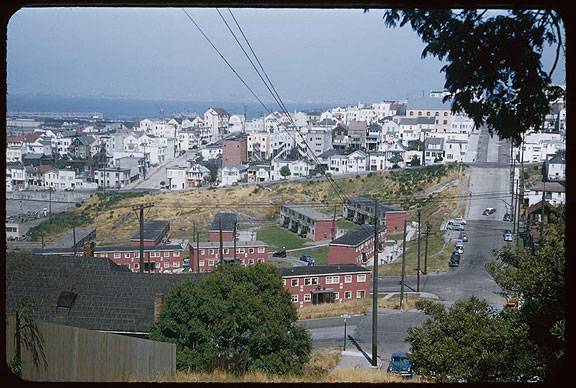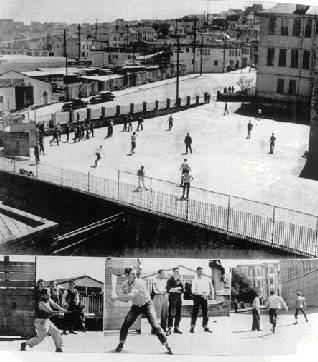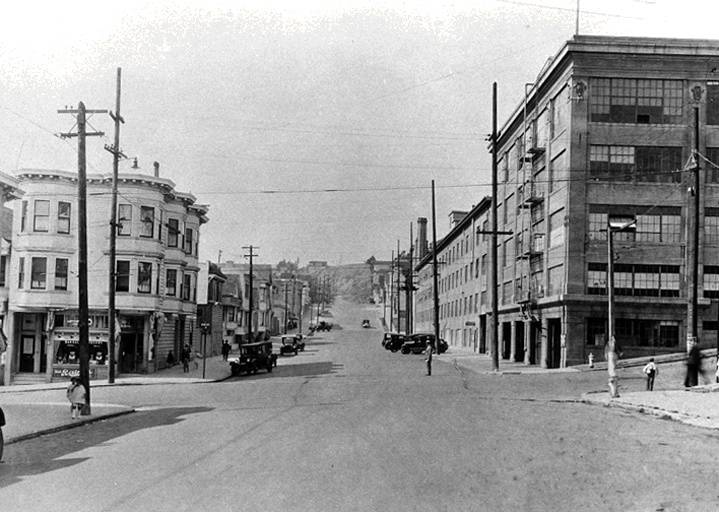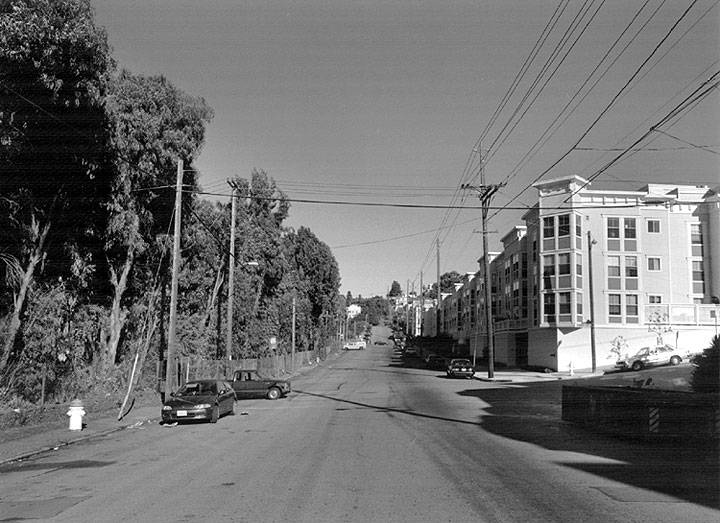1955 Demographic Study: Difference between revisions
(categories and links) |
(added photo) |
||
| (7 intermediate revisions by 2 users not shown) | |||
| Line 1: | Line 1: | ||
'''<font face = Papyrus> <font color = maroon> <font size = 4>Historical Essay</font></font> </font>''' | |||
''by Cheryl Clark, 1964'' | |||
[[Image:Cushman-May-17-1954-ene-19th-and-DeHaro-projects-on-Pothill-P07134.jpg]] | |||
'''May 17, 1954, view of Public Housing projects at 19th and DeHaro. Later to be cleared for public school, and slopes behind have been [[Potrero Commons 18th-Wisconson|filled with condominiums]], after a lengthy [[How to Fight City Hall and Lose|public effort]] to maintain the open space.''' | |||
[http://webapp1.dlib.indiana.edu/cushman/ ''Charles Cushman Collection: Indiana University Archives (P07134)''] | |||
[[Image:pothill$lick-wilmerding-1950s.jpg]] | [[Image:pothill$lick-wilmerding-1950s.jpg]] | ||
| Line 11: | Line 21: | ||
The study provided many charts showing the average San Francisco area in relation to Potrero Hill. The following presents some interesting comparisons to the housing on the hill, as opposed to the rest of San Francisco. | The study provided many charts showing the average San Francisco area in relation to Potrero Hill. The following presents some interesting comparisons to the housing on the hill, as opposed to the rest of San Francisco. | ||
HOUSING CHARACTERISTICS OF POTRERO HILL | '''HOUSING CHARACTERISTICS OF POTRERO HILL''' | ||
'''Type of Structure S.F. Total Potrero Hill ''' | '''Type of Structure S.F. Total Potrero Hill ''' | ||
| Line 50: | Line 60: | ||
Land Use: Retain all existing land used for living area and include the Carolina War Housing. Move the Dutch Boy Paint Factory at Twenty-Third and Kansas St., and convert the land to living area. Establish a supermarket at the site of Twentieth and Connecticut, and in conjunction with this, provide off-the-street parking. An area with a population of over 10,000 can support a multi-purpose shopping area. | Land Use: Retain all existing land used for living area and include the Carolina War Housing. Move the Dutch Boy Paint Factory at Twenty-Third and Kansas St., and convert the land to living area. Establish a supermarket at the site of Twentieth and Connecticut, and in conjunction with this, provide off-the-street parking. An area with a population of over 10,000 can support a multi-purpose shopping area. | ||
[[Image:Kansas at 24th street 1930.jpg]] | |||
'''Northward view at corner of 24th and Kansas, 1930, paint factory at right''' | |||
''Photo: Private Collection'' | |||
[[Image:24VMT993.jpg]] | |||
'''North at corner of 24th and Kansas, 1993, paint factory now replaced by condominiums.''' | |||
''Photo: David Green'' | |||
General repair of streets and painting of traffic lines at blind intersections would improve traffic. Transit lines could be improved if the buses were rerouted through the areas which are more heavily populated. | General repair of streets and painting of traffic lines at blind intersections would improve traffic. Transit lines could be improved if the buses were rerouted through the areas which are more heavily populated. | ||
| Line 61: | Line 83: | ||
Neighborhood groups have emerged, and are attacking zoning laws and slums with increasing vigor. Each new building project on the hill is viewed with critical alarm. An area considered by many to be on the wrong side of the tracks, is not happy that it is in such an isolated position. | Neighborhood groups have emerged, and are attacking zoning laws and slums with increasing vigor. Each new building project on the hill is viewed with critical alarm. An area considered by many to be on the wrong side of the tracks, is not happy that it is in such an isolated position. | ||
Names of streets as they appeared in 1876 from Langley's Directory of San Francisco: | '''Names of streets as they appeared in 1876 from Langley's Directory of San Francisco:''' | ||
El Dorado (15th) | El Dorado (15th) | ||
| Line 89: | Line 111: | ||
Islais Creek | Islais Creek | ||
[[Neighborhood House |Prev. Document]] [[Reshaping Potrero Hill |Next Document]] | [[Neighborhood House |Prev. Document]] [[Reshaping Potrero Hill |Next Document]] | ||
[[category:Potrero Hill]] [[category:Italian]] [[category:Russian]] [[category: | [[category:Potrero Hill]] [[category:Italian]] [[category:Russian]] [[category:African-American]] [[category:1870s]] [[category:1950s]] [[category:Housing]] | ||
Latest revision as of 09:46, 2 January 2015
Historical Essay
by Cheryl Clark, 1964
May 17, 1954, view of Public Housing projects at 19th and DeHaro. Later to be cleared for public school, and slopes behind have been filled with condominiums, after a lengthy public effort to maintain the open space.
Charles Cushman Collection: Indiana University Archives (P07134)
Lick-Wilmerding School at 17th & Utah, 1950s
Photo: Potrero Hill Archive Project
In 1955, the San Francisco Department of City Planning undertook a study of neighborhood conservation on Potrero Hill. The first step in the plan was to find what conditions did exist, and if the hill was a blighted area. The population at the time of the study was about 11,450. Of that number, 21% were born in a foreign country, and 5% were Negro. Of the immigrants, 29% were Italian and 18% were Russian.
True to the past history of the Potrero, two-thirds of the male population were employed as draftsmen, foremen, operatives, and laborers. Thirty percent of the women over age fourteen were employed. This was 3% more than the citywide average. The median annual income was $3,119, or about $100 higher than the median for the city.
The study provided many charts showing the average San Francisco area in relation to Potrero Hill. The following presents some interesting comparisons to the housing on the hill, as opposed to the rest of San Francisco.
HOUSING CHARACTERISTICS OF POTRERO HILL
Type of Structure S.F. Total Potrero Hill
1 & 2 units 51.3% 68.3%
3 & 4 units 11.6% 12.7%
5 or more units 37.1% 19.0%
Owner occupied units 2.6% 9.0%
Units built 1919 & earlier 50.0% 59.4%
The hill has never taken advantage of the excellent weather or view in regard to income property. This is shown in the higher rate of 1 and 2 unit buildings on the previous chart. Owner-occupied homes are almost 6.4% higher than the rest of the city. Working families of the Potrero are not the nomadic type. They tend to live in the same house throughout their life. Potrero Hill, compared to the city average, has eighteen percent less of five or more dwelling unit buildings.
This area is also a leader in older units. As noted earlier, the Potrero was not a victim of the Nineteen-Six Fire, and many of the houses are remains of an earlier period. Some of these homes are assets to the community, standing aloof from the present, as monuments to the past. On the other hand, older homes, if run down, will discredit an area. At the time this research was assembled by the city, most of the old Victorian homes were in need of repair.
Another problem are vacant lots. These lots tend to be collection spots for trash and waste. Due to the poor planning of streets, and the neglect of removing or improving hills and cliffs, many small sections are not suitable for construction.
From the material in the city report, it appears that many, 83.5% of the dwellers on the hill had lived in the same house for five years or more. Four percent had come from another country and eleven percent had moved here from other parts of the U.S. One could conclude that the decay was not caused by outside forces, but from within or because or a lack of interest. A community which is in many ways an island within a city, can become a victim of neglect. Such was the problem of Potrero Hill. Of the dwelling units on Potrero in 1955, nearly 60% were built in 1919 or earlier, and 10.7% were without private baths or dilapidated. The media rent was $33.73 per month. The median value per single family structure was $7,319 [(*"current" value is about $21,000).]
Schools were not within a desirable distance and the transportation was inadequate. The only junior high schools in the area were in the Mission District. The same was true for high schools.
The Potrero District does have 16.32 acres of parks and playgrounds. The three parks, Jackson, Potrero Playfield, and McKinley Square, are located a good distance from one another. Each park serving its own particular section of the hill.
Shopping on Potrero is limited to small shops. A shopping area on 18th Street has a number of shops of various kinds, but the general condition is poor. Many of the buildings are vacant and in need of repair. Twentieth Street is fast becoming the major trading area, including a drug store, medical center, library, barber shops, and grocery stores.
This was the condition of Potrero Hill as reported by the city planning commission in 1955. The opinion of the study was that Potrero was in need of renewal. Only a small part of the area was actually blighted and any further deterioration could be stopped. The basic plan was as follows:
1. Land Use
2. Circulation
3. Public Facilities
4. Neighborhood Appearances
Land Use: Retain all existing land used for living area and include the Carolina War Housing. Move the Dutch Boy Paint Factory at Twenty-Third and Kansas St., and convert the land to living area. Establish a supermarket at the site of Twentieth and Connecticut, and in conjunction with this, provide off-the-street parking. An area with a population of over 10,000 can support a multi-purpose shopping area.
Northward view at corner of 24th and Kansas, 1930, paint factory at right
Photo: Private Collection
North at corner of 24th and Kansas, 1993, paint factory now replaced by condominiums.
Photo: David Green
General repair of streets and painting of traffic lines at blind intersections would improve traffic. Transit lines could be improved if the buses were rerouted through the areas which are more heavily populated.
A section between Twenty-Second Street and Twentieth, and Vermont and Rhode Island, would be subject to complete renovation. This would include enlarging McKinley Park. Several new units of housing, a total of twenty-eight apartments, would be placed above Vermont and Twenty-Second. Numerous trees would be planted along the freeway, and along the streets to provide a more pleasant surrounding.
Nine years have passed since this study was undertaken. In that nine year period, a change has taken place on the hill. Although a vast number of apartments have been built on the hill, it appears that Potrero will not suffer the same fate as Twin Peaks. Although it does not possess as spectacular a view as Potrero, Twin Peaks has become the victim of mass uninteresting housing, capitalizing on a fast turnover and impressive view.
Always an island in the city, the Potrero has become a refuge to a new breed. In the recent years, the hill has become the home of artists and writers. The steep sides of the hill and the sunny weather, seem to spawn artistic ability. With this new life in the area, a growing pride is developing in the community. Old Victorians are regaining their lost grandeur with fresh paint and trim. Property values have increased at an alarming rate.
Neighborhood groups have emerged, and are attacking zoning laws and slums with increasing vigor. Each new building project on the hill is viewed with critical alarm. An area considered by many to be on the wrong side of the tracks, is not happy that it is in such an isolated position.
Names of streets as they appeared in 1876 from Langley's Directory of San Francisco:
El Dorado (15th)
Center (16th)
Santa Clara (17th)
Mariposa
Salano (18th)
Butte (19th)
Napa (20th)
Serria (22nd)
Nevada (23rd)
Yolo
Colusa
Tulare
Islais Creek




